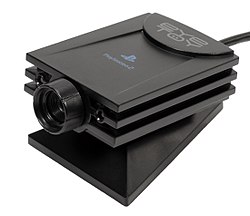| Game title | Year released | Developer | Publisher |
|---|
| EyeToy: Play | July 4, 2003 (Europe)
November 4, 2003 (North America) | London Studio | Sony Computer Entertainment |
| EyeToy: Groove | November 14, 2003 (Europe)
April 20, 2004 (North America) | London Studio | Sony Computer Entertainment |
| Kaiketsu Zorori Mezase! Itazura King | April 28, 2004 (Japan) | Bandai | Bandai |
| U-Move Super Sports | July 15, 2004 (Japan)
October 22, 2004 (Europe) | Konami | Konami |
| EyeToy: Monkey Mania | August 4, 2004 (Japan)
March 18, 2005 (Europe) | Japan Studio | Sony Computer Entertainment |
| Nicktoons Movin' | October 21, 2004 (North America)
November 26, 2004 (Europe) | Mass Media | THQ |
| Sega Superstars | October 22, 2004 (Europe)
November 2, 2004 (North America)
November 11, 2004 (Japan) | Sonic Team | Sega |
| EyeToy: AntiGrav | November 9, 2004 (North America)
March 2005 (Europe) | Harmonix | Sony Computer Entertainment |
| EyeToy: Play 2 | November 5, 2004 (Europe)
August 16, 2005 (North America) | London Studio | Sony Computer Entertainment |
| Bakufuu Slash! Kizna Arashi | November 14, 2004 (Japan) | Sony Computer Entertainment | Sony Computer Entertainment |
| Disney Move | November 19, 2004 (Europe) | Artificial Mind & Movement | Buena Vista Games |
| Card Captor Sakura: Sakura-Chan to Asobo! | December 2, 2004 (Japan) | NHK Software | NHK Software |
| Bobobo-bo Bo-bobo Assemble! Motion Bo-bobo | December 16, 2004 (Japan) | Hudson Soft | Hudson Soft |
| EyeToy: EduKids | January 20, 2005 (Korea) | SCE Korea
Arisu Media | Sony Computer Entertainment Korea |
| EyeToy: Chat | February 11, 2005 (Europe) | London Studio | Sony Computer Entertainment Europe |
| EyeToy: Tales | March 2005 (Korea) | SCE Korea | Sony Computer Entertainment Korea |
| Onmyou Taisenki - Byakko Enbu | March 31, 2005 (Japan) | Matrix Software | Bandai |
| C@M-Station | April 28, 2005 | Arduc | Arduc |
| YetiSports Arctic Adventures | July 2005 (Europe) | Pirate Games | JoWooD Productions |
| EyeToy: Kinetic | September 23, 2005 (Europe)
November 8, 2005 (North America) | London Studio | Sony Computer Entertainment |
| SpyToy | October 14, 2005 (Europe)
November 15, 2005 (North America) | London Studio | Sony Computer Entertainment |
| EyeToy: Play 3 | November 4, 2005 (Europe) | London Studio | Sony Computer Entertainment Europe |
| Rhythmic Star! | March 10, 2006 (Europe) | Namco | Ignition Entertainment/Namco |
| Clumsy Shumsy | October 27, 2006 (Europe) | Phoenix Games | Phoenix Games |
| EyeToy: Kinetic Combat | November 17, 2006 (Europe) | London Studio | Sony Computer Entertainment Europe |
| EyeToy Play: Sports | December 31, 2006 (Europe) | London Studio | Sony Computer Entertainment Europe |
| Bob the Builder | August 23, 2007 (Europe) | Atomic Planet Entertainment | Mastertronic Group |
| Thomas & Friends: A Day at the Races | August 24, 2007 (Europe) | Broadsword Interactive | Mastertronic Group |
| EyeToy Play: Astro Zoo | November 2, 2007 (Europe) | London Studio | Sony Computer Entertainment Europe |
| EyeToy Play: Hero | 2008 (Europe) | London Studio | Sony Computer Entertainment Europe |
| EyeToy Play: PomPom Party | 2008 (Europe) | London Studio | Sony Computer Entertainment Europe |

